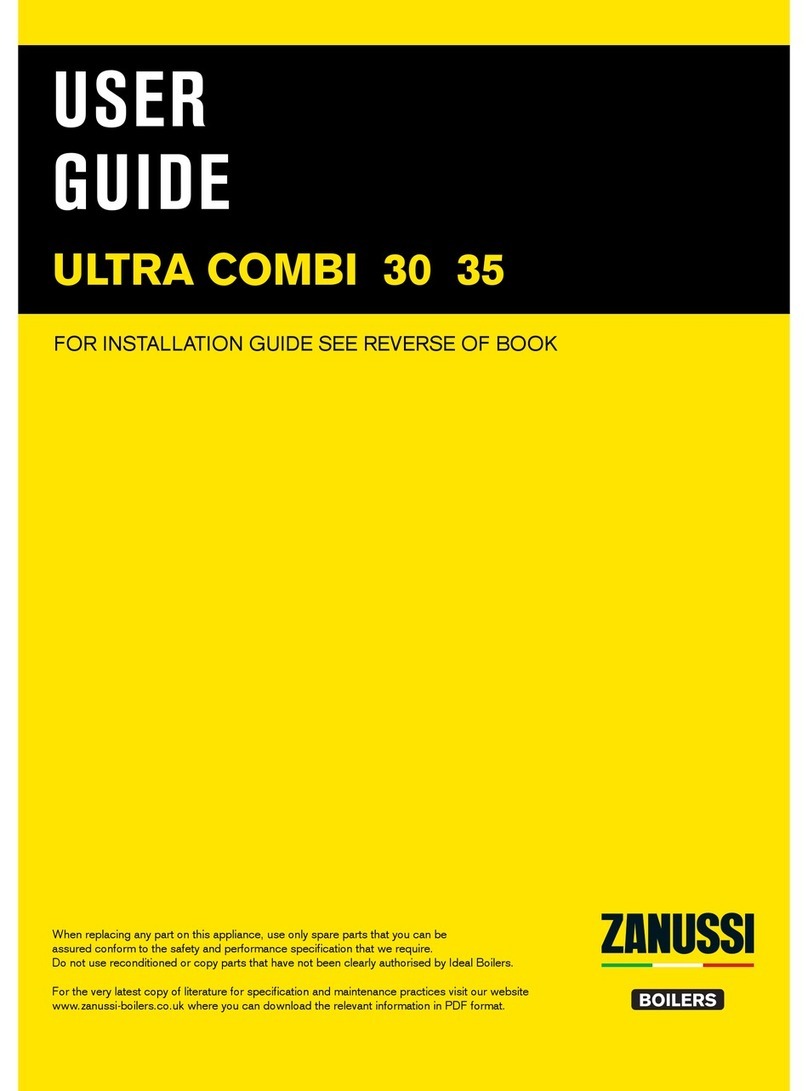
9
Installation and Servicing
GENERAL
OPTIONAL EXTRA KITS
• Horizontal Flue Terminal 1000mm long
• Horizontal Flue Terminal 600mm long
•
Horizontal Flue Terminal 600mm long (Weather Protection)
• Horizontal Telescopic Flue
• Flue Finishing Kit
• Flue Extension Ducts (1000mm long)
• Flue Extension Ducts (2000mm long)
• Flue Extension Ducts (500mm long)
30-up to 8m
35-up to 6m
• 90o Elbow Kit (maximum per installation).
30-upto 6 elbows
35-upto 4 elbows
• 45o Elbow Kit (maximum per installation).
30-upto 6 elbows
35-upto 4 elbows
• Concentric Flue Screw Retaining Kit
• Roof Flue Kit (to a maximum of 7.5m)
• Powered Vertical Flue Kit (5m primary and 17m secondary
is a typical maximum length. For alternative details refer to
Powered Vertical Instructions)
• Weather Collar
• High Level Flue Outlet Kit
• Flue Deector Kit
• Balcony Flue Kit
• Soft Flue Kit
• Raised Horizontal Flue Outlet Kit
• Adjustable Flue Support Bracket
• Mechanical Timer (24 hr) Kit
• Electronic Timer (7 day) kit
• RF Mechanical Programmable Room Thermostat (24 hr)
kit
• RF Electronic Programmable Room Thermostat (7 day)
kit
• Weather Compensation Kit
• Stand-Off Kit
• Stand-Off Kit (inc. pipes)
• DHW Expansion Vessel Kit
• Pre-Piping Frame Kit
• Condensate Pump Kit
• Security Bracket Kit
• PRV Wall Outlet Kit
• Pressure Gauge Extension Kit
• RF Mechanical Timer and Room Thermostat Kit
• OpenTherm Harness Kit
• Outside Sensor Kit
SAFETY
Current Gas Safety (installation and use) regulations or rules
in force:
The appliance is suitable only for installation in GB and IE and
should be installed in accordance with the rules in force.
In GB, the installation must be carried out by a Gas Safe
Registered Engineer. It must be carried out in accordance with
the relevant requirements of the:
• Gas Safety (Installation and Use) Regulations
• The appropriate Building Regulations either The Building
Regulations, The Building Regulations (Scotland), Building
Regulations (Northern Ireland).
• The Water Fittings Regulations or Water byelaws in Scotland.
• The Current I.E.E. Wiring Regulations.
Where no specic instructions are given, reference should be
made to the relevant British Standard Code of Practice.
In IE, the installation must be carried out by a Registered Gas
Installer (RGII) and installed in accordance with the current edition
of I.S.813 “Domestic Gas Installations”, the current Building
Regulations and reference should be made to the current ETCI
rules for electrical installation.
Detailed recommendations are contained in the following British
Standard Codes of Practice:
BS. 5440:1 Flues (for gas appliances of rated input not
exceeding 70 kW).
BS. 5440:2 Ventilation (for gas appliances of rated input not
exceeding 70 kW).
BSEN. 12828:2003 Heating Systems in buildings: Design for
water based heating systems.
BSEN 12831:2003 Heating Systems in buildings: Method for
calculation of the design heat load.
BSEN 14336:2004 Heating Systems in buildings: Installation
and commissioning of water based heating
systems.
BS. 5546 Installation of gas hot water supplies for domestic
purposes (2nd Family Gases)
BS. 6798 Installation of gas red hot water boilers of rated
input not exceeding 70 kW.
BS. 6891 Low pressure installation pipes.
Health & Safety Document No. 635.
The Electricity at Work Regulations, 1989.
The manufacturer’s notes must NOT be taken, in any way, as
overriding statutory obligations.
IMPORTANT. These appliances are CE certicated for safety
and performance. It is, therefore, important that no external
control devices, e.g. ue dampers, economisers etc., are
directly connected to these appliances unless covered by
these Installation and Servicing Instructions or as otherwise
recommended by the manufacturer in writing. If in doubt please
enquire.
Any direct connection of a control device not approved by the
manufacturer could invalidate the certication and the normal
appliance warranty. It could also infringe the Gas Safety
Regulations and the above regulations.
SAFE HANDLING OF SUBSTANCES
No asbestos, mercury or CFCs are included in any part of the
boiler or its manufacture.






























